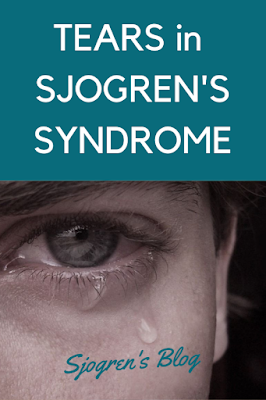What Your Tears Can Tell Us: Study on Sjögren’s and Eye Symptoms
A 2022 study looked closely at the tears of people with Primary Sjögren’s to better understand how tear chemistry relates to eye discomfort and dryness. The goal? To find clues that might explain why some people experience more severe symptoms than others.
Why Study Tears?
In Sjögren’s, the immune system attacks moisture-producing glands—including those that make tears. This leads to dry, irritated eyes and can affect vision, comfort, and quality of life. Researchers wanted to know: do certain proteins in tears relate to how bad the symptoms feel?
What They Did
21 women with PSS and 21 healthy women without dry eye took part.
Eye doctors measured tear quantity and quality using tests like:
Schirmer test (tear production)
Tear breakup time (how long tears stay on the eye)
Tear meniscus height (how much tear fluid is present)
Staining scores (how damaged the eye surface is)
Participants also rated their symptoms using tools like:
ESSPRI (a scale for fatigue, pain, and dryness)
OSDI (a dry eye symptom questionnaire)
ESSPRI is a patient-reported index designed to assess the severity of patients' symptoms in primary SS.
Tear samples were collected and frozen, then tested for three small proteins—called chemokines—that help guide immune cells. These proteins were:
CXCL8
CXCL10
CCL2
What They Found
CXCL8 levels were about the same in both groups.
People with PSS had lower levels of CXCL10 and CCL2 compared to healthy controls.
Those with worse eye symptoms had the lowest CXCL10 levels.
CCL2 levels were linked to tear volume and eye surface damage.
What It Means
This study suggests that lower levels of certain immune-related proteins in tears—especially CXCL10—might be connected to more severe eye discomfort in Sjögren’s. It’s a small but important step toward understanding the biology behind our symptoms.
While this doesn’t lead to a treatment just yet, it helps researchers identify possible markers that could guide future therapies or help tailor care to individual needs.
Luminometry is the process of measuring light. Luminometers are the instruments that do the measuring.
The tear meniscus height can be used to estimate tear volume. A tear meniscus height less than 0.25 mm is suggestive of dry eye.
What You Can Do
This study reminds us that even our tears carry clues about how Sjögren’s affects us—and that science is slowly uncovering those clues. While tear testing isn’t yet part of routine care, it may become more important in the future.
If you’re living with dry eyes or discomfort:
Track your symptoms—note when they worsen, what helps, and how they affect daily life.
Talk to your eye care provider about your tear volume and surface health. Ask if tests like Schirmer or staining scores might offer insight.
Share this research with your care team. It may help guide more personalized support.
And most importantly, remember: your symptoms are real, and your comfort matters. You deserve care that listens to your body and honors your experience.
'It does the job. I have sjogen's syndrome and use this at night. It offers a great coating and lasts all night. My eyes stay moist.'
'I have had dry eyes most of my adult life. I have tried several brands of night time eye ointment. Until I came across Systane, I continued to have a problem. Waking up in the middle of the night with what felt like sand in my eyes, which meant my eyes were runny. This caused me to wake up and I was unable to get back to sleep. Systane in my opinion is the very best night time dry eye ointment!'


Comments
Post a Comment